By Leen Randell
Updated: Jul 04, 2024
10 Best Herbal Decoctions For Allergies
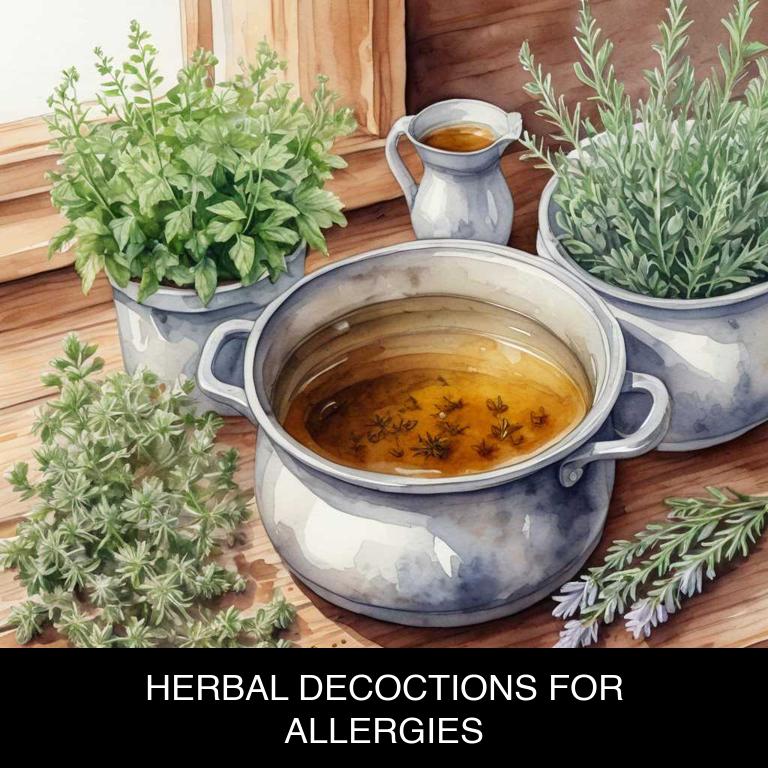
Herbal decoctions for allergies are a natural and effective way to alleviate symptoms associated with seasonal and environmental allergies.
These decoctions are made by steeping herbs in hot water, releasing their medicinal properties, which can help reduce inflammation, itching, and congestion caused by allergens. Examples of herbal decoctions that help with allergies include nettle leaf, quercetin-rich herbs like goldenrod and stinging nettle, and antihistamine-rich herbs like butterbur.
By incorporating these decoctions into one's daily routine, individuals can experience relief from allergy symptoms, allowing them to breathe easier, sleep better, and enjoy outdoor activities without discomfort.
The following article describes in detail the most important decoctions for allergies, including medicinal properties, parts of herbs to use, and recipes for preparations.
- 1. Petasites hybridus
- 2. Quercus robur
- 3. Ginkgo biloba
- 4. Pelargonium sidoides
- 5. Taraxacum officinale
- 6. Boswellia serrata
- 7. Glycyrrhiza glabra
- 8. Galphimia glauca
- 9. Bacopa monnieri
- 10. Camellia sinensis
- What is the best combination of herbal decoctions to use for allergies?
- What ailments similar to allergies are treated with herbal decoctions?
1. Petasites hybridus
Butterbur decoctions helps with allergies because of its potent anti-inflammatory properties, which reduce swelling in the nasal passages and sinuses.
The flavonoids and sesquiterpenes present in butterbur work to neutralize histamine release, alleviating symptoms like congestion, sneezing, and itching. Additionally, butterbur's natural antispasmodic properties relax the airways, making it easier for mucus to drain out of the body.
By reducing inflammation and opening up airways, butterbur decoctions provide relief from allergy-induced discomfort, allowing individuals to breathe easier and feel more comfortable.
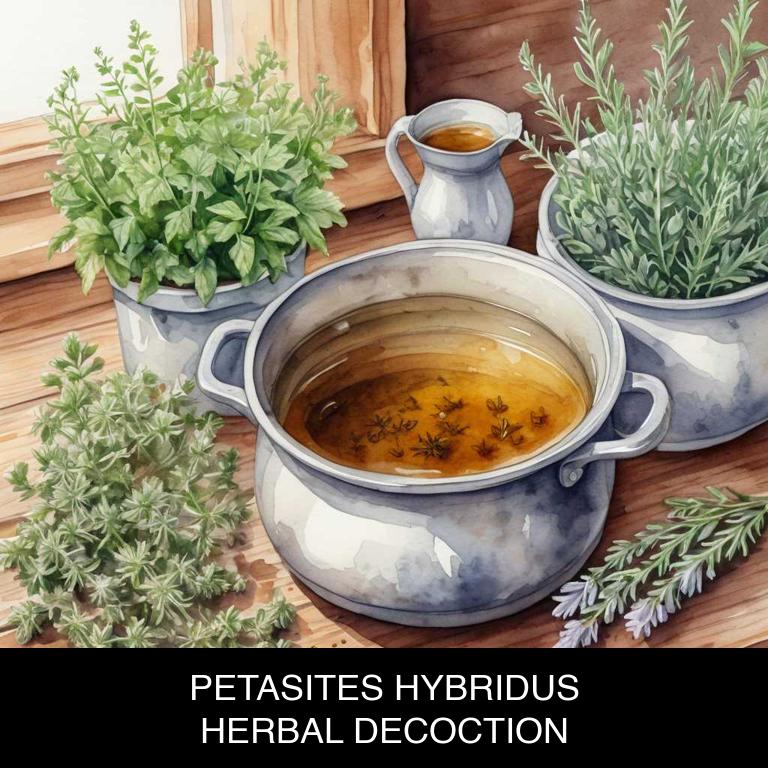
Medicinal Constituents
The list below shows the primary medicinal constituents in Petasites hybridus decoctions that help with allergies.
- Iridoid glycosides: These compounds help alleviate allergy symptoms by inhibiting the release of histamine, a key player in the allergic response.
- Flavonoids: Flavonoids in Petasites hybridus decoctions act as antioxidants and anti-inflammatory agents, reducing inflammation and oxidative stress associated with allergic reactions.
- Phenylethanoid glycosides: Phenylethanoid glycosides have been shown to possess anti-allergic properties, including inhibiting the production of pro-inflammatory cytokines and reducing histamine release.
Parts Used
The list below shows the primary parts of butterbur used to make decoctions for allergies.
- Roots: Roots are the most commonly used part for making decoctions due to their high concentration of bioactive compounds that help alleviate allergy symptoms.
- Leaves: Leaves are also widely used for decoctions as they contain a significant amount of flavonoids and phenolic acids that have anti-inflammatory properties, useful for allergy relief.
- (optional) stems: Stems can be used for decoctions, although they contain less bioactive compounds compared to roots and leaves, they still contribute to the overall therapeutic effect of Petasites hybridus decoctions.
Quick Recipe
The following recipe gives a procedure to make a basic butterbur for allergies.
- Harvest petasites hybridus roots and rhizomes in the fall after the plant has completed its growth cycle.
- Dry the harvested petasites hybridus roots and rhizomes in a warm place for 7 to 10 days.
- Chop the dried petasites hybridus roots and rhizomes into small pieces weighing about 10 grams.
- Steep 10 grams of chopped dried petasites hybridus roots and rhizomes in 1 liter of boiling water for 10 minutes.
- Strain and cool the decoction to a comfortable temperature for consumption within 30 minutes.
2. Quercus robur
English oak decoctions helps with allergies because they contain a range of bioactive compounds that work to reduce inflammation and congestion in the body.
The decoction's antimicrobial properties help to eliminate allergens from the system, while its anti-inflammatory effects soothe itchy eyes and skin. Additionally, English oak's antioxidant properties protect cells from damage caused by free radicals, further reducing allergic reactions.
By calming the body's response to allergens, English oak decoctions can provide relief from common allergy symptoms such as itching, sneezing, and congestion.
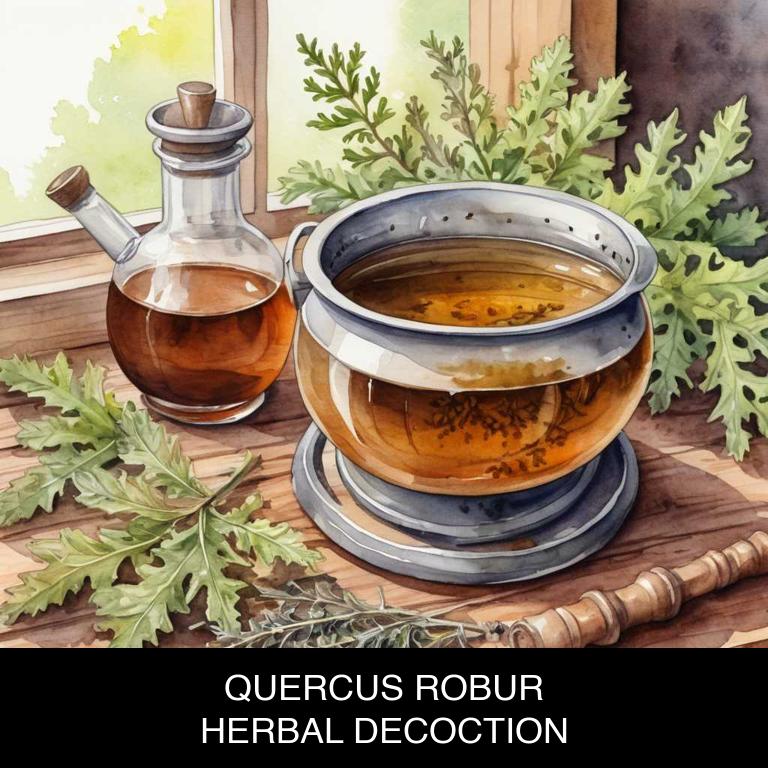
Medicinal Constituents
The list below shows the primary medicinal constituents in Quercus robur decoctions that help with allergies.
- Quercetin: A flavonoid phenolic compound that helps to reduce histamine release, inflammation, and mucus production, making it effective in alleviating allergy symptoms.
- Ellagic acid: A phenolic compound with antioxidant and anti-inflammatory properties that helps to reduce inflammation and oxidative stress in the body, providing relief from allergy symptoms.
- Oligomeric proanthocyanidins: A type of flavonoid polyphenol that has anti-inflammatory and antioxidant properties, helping to reduce inflammation and stabilize mast cells, which are involved in the allergic response.
Parts Used
The list below shows the primary parts of english oak used to make decoctions for allergies.
- Buds: They are used to make decoctions due to their antihistamine and anti-inflammatory properties, which help to alleviate allergy symptoms.
- Leaves: The leaves of Quercus robur are used in decoctions to address allergies due to their rich content of antioxidants and flavonoids, which possess anti-inflammatory and antihistamine effects.
- Barks: Quercus robur bark is utilized in decoctions for its astringent and anti-inflammatory properties, which can help to alleviate allergy symptoms such as itching and congestion.
Quick Recipe
The following recipe gives a procedure to make a basic english oak for allergies.
- Harvest approximately 20g of quercus robur bark and roots in the fall season when the tree is dormant.
- Dry the harvested quercus robur material in a warm place for 2 weeks to remove excess moisture.
- Combine 1g of the dried quercus robur material with 100ml of boiling water in a heat-resistant container.
- Steep the mixture for 5-10 minutes to allow the active compounds to infuse into the water.
- Strain the decoction through a fine mesh sieve into a separate container to remove the solids.
3. Ginkgo biloba
Maidenhair tree decoctions helps with allergies because of its anti-inflammatory properties, which can reduce congestion and itching associated with allergic reactions.
The decoction's antihistamine-like effects can also alleviate symptoms such as runny nose, sneezing, and watery eyes. Additionally, the herbal extract has been shown to inhibit the release of histamine, a chemical released during an allergic reaction, further reducing symptoms and improving respiratory function.
By incorporating maidenhair tree decoctions into their daily routine, individuals may experience relief from allergy-related discomforts.

Medicinal Constituents
The list below shows the primary medicinal constituents in Ginkgo biloba decoctions that help with allergies.
- Flavonoids: They help with allergies by reducing inflammation and oxidative stress in the body, which can contribute to allergic reactions.
- Bilobalide: It helps with allergies by modulating the immune system and reducing the release of pro-inflammatory mediators, thus alleviating allergic symptoms.
- Ginkgolides: They help with allergies by inhibiting the production of leukotrienes, which are pro-inflammatory molecules involved in the pathogenesis of allergic reactions.
Parts Used
The list below shows the primary parts of maidenhair tree used to make decoctions for allergies.
- Leaves: They are the most commonly used part due to their rich content of flavonoids and terpenoids, which are believed to have anti-inflammatory and antioxidant properties that help alleviate allergy symptoms.
- Seeds: Ginkgo seeds are used in decoctions due to their potential to reduce inflammation and improve blood flow, which can help alleviate symptoms associated with allergies such as congestion and sinus pressure.
- Barks: Ginkgo barks are used in decoctions because of their antioxidant properties and potential to improve blood flow, which can help alleviate allergy symptoms such as itchiness and skin irritation.
Quick Recipe
The following recipe gives a procedure to make a basic maidenhair tree for allergies.
- Harvest 1-2 cups of dried ginkgo biloba leaves from a reputable source and store them in an airtight container.
- Rinse 1 teaspoon of dried ginkgo biloba leaves in cold water to remove any impurities or debris.
- Steep 1 teaspoon of dried ginkgo biloba leaves in 1 cup of boiling water for 5-10 minutes.
- Strain the decoction through a cheesecloth or fine-mesh sieve into a clean container and discard the solids.
- Allow the decoction to cool to room temperature before storing it in the refrigerator for up to 2 days.
4. Pelargonium sidoides
Umckaloabo decoctions helps with allergies because they contain a unique combination of bioactive compounds that have anti-inflammatory and antihistamine properties.
The decoction's active ingredients, such as ursolic acid and taraxasterol, work together to reduce inflammation in the nasal passages and sinuses, alleviating symptoms like congestion and runny nose. Additionally, umckaloabo's natural histamine-blocking effects help prevent allergic reactions, providing relief from itchy eyes, sneezing, and coughing.
By targeting multiple pathways, umckaloabo decoctions offer a comprehensive approach to managing allergies and promoting respiratory health.
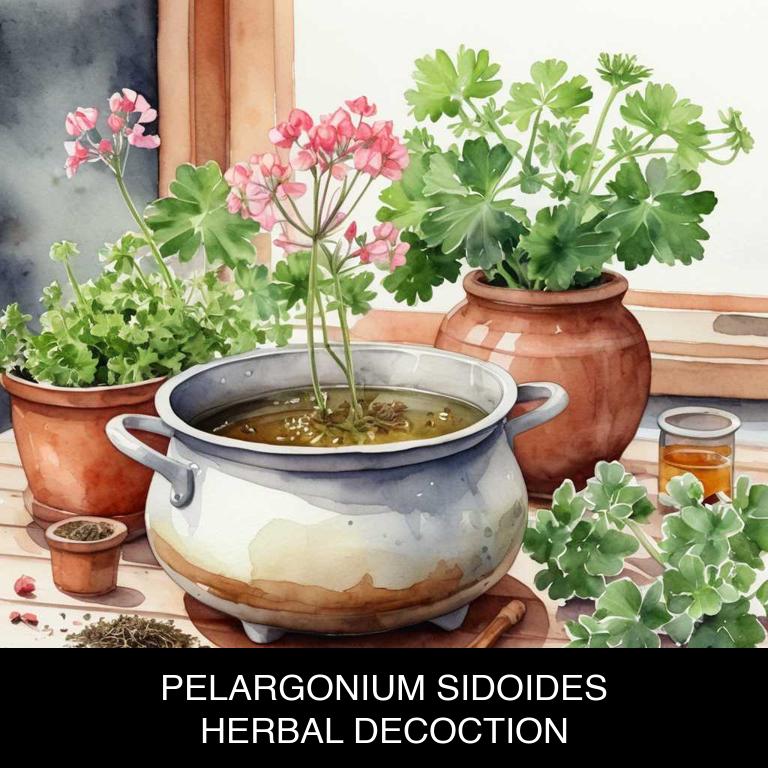
Medicinal Constituents
The list below shows the primary medicinal constituents in Pelargonium sidoides decoctions that help with allergies.
- Ursolic acid: This triterpene may help reduce inflammation associated with allergic reactions, thereby alleviating symptoms.
- Geraniin: A phenolic compound, geraniin may exhibit antioxidant properties that help counteract oxidative stress caused by allergic responses.
- Rosmarinic acid: This phenolic acid may have anti-inflammatory and immunomodulatory effects, which could contribute to the relief of allergy symptoms.
Parts Used
The list below shows the primary parts of umckaloabo used to make decoctions for allergies.
- Roots: They are commonly used due to their high concentration of bioactive compounds, which are believed to have anti-inflammatory and antiviral properties.
- Leaves: They are often used in decoctions because of their ease of harvesting and relatively high content of flavonoids, which may contribute to their medicinal properties.
- Buds: They are sometimes used in decoctions because they contain a higher concentration of bioactive compounds compared to the leaves, making them a popular choice for traditional medicine.
Quick Recipe
The following recipe gives a procedure to make a basic umckaloabo for allergies.
- Harvest 15 20 grams of fresh roots and dried roots in a 2:1 ratio of fresh to dried material.
- Dry the harvested material at 50 degrees celsius for 2 hours to reduce moisture content.
- Grind the dried material into a fine powder using a mortar and pestle or blender.
- Combine 2 3 grams of the powder with 100 milliliters of boiling water in a heat resistant container.
- Steep the mixture for 5 10 minutes and strain the decoction through a cheesecloth or fine mesh sieve.
5. Taraxacum officinale
Dandelion decoctions helps with allergies because they contain anti-inflammatory compounds that reduce swelling in the nasal passages and sinuses.
The antioxidants present in dandelion also help to neutralize free radicals, which can contribute to allergic reactions. Furthermore, dandelion's diuretic properties help to flush out excess mucus and toxins from the body, providing relief from congestion and sinus pressure.
By reducing inflammation and eliminating allergens, dandelion decoctions provide a natural and effective way to alleviate allergy symptoms.

Medicinal Constituents
The list below shows the primary medicinal constituents in Taraxacum officinale decoctions that help with allergies.
- Apigenin: A flavonoid that helps reduce inflammation and modulate the immune response, providing relief from allergy symptoms.
- Quercetin: A flavonoid that acts as an antihistamine and anti-inflammatory agent, helping to alleviate symptoms such as itching, sneezing, and congestion associated with allergies.
- Saponins: A type of glycoside that exhibits anti-inflammatory and immunomodulatory properties, which can help regulate the immune system and reduce allergic reactions.
Parts Used
The list below shows the primary parts of dandelion used to make decoctions for allergies.
- Leaves: They are rich in taraxasterol, a compound that helps reduce inflammation and alleviate allergy symptoms.
- Flowers: The flowers contain taraxanthin, a pigment that acts as an anti-inflammatory agent, helping to combat allergy symptoms.
- Roots: The roots of the plant contain a range of bioactive compounds, including taraxasterol and taraxeryl acetate, which help to reduce inflammation and alleviate allergy symptoms.
Quick Recipe
The following recipe gives a procedure to make a basic dandelion for allergies.
- Gather 15-30 fresh taraxacum officinale roots weighing about 50-100 grams for decoction preparation.
- Clean the roots thoroughly by rinsing them in cold running water for several minutes.
- Chop the roots into small pieces and combine them with 1 liter of water in a saucepan.
- Bring the mixture to a boil and then reduce the heat to a low simmer for 10-15 minutes.
- Strain the decoction through a cheesecloth or a fine-mesh sieve into a clean container.
6. Boswellia serrata
Frankincense decoctions helps with allergies because of its potent anti-inflammatory and antioxidant properties.
The decoction's active compounds, including boswellic acids and flavonoids, work to reduce inflammation in the respiratory tract, relieving congestion and discomfort associated with allergic reactions. Additionally, frankincense has natural antihistamine-like effects, helping to neutralize histamine release and alleviate symptoms such as itching, sneezing, and runny nose.
By targeting multiple pathways, frankincense decoctions provide comprehensive relief from allergy-related issues.
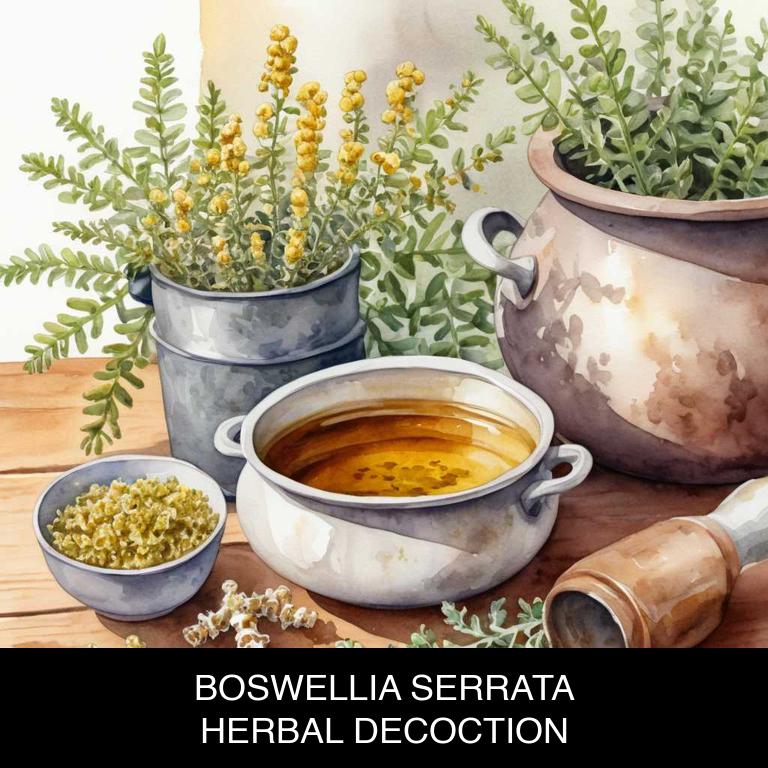
Medicinal Constituents
The list below shows the primary medicinal constituents in Boswellia serrata decoctions that help with allergies.
- Boswellic acids: These triterpenoid acids have anti-inflammatory properties, which help alleviate symptoms associated with allergic reactions by reducing inflammation and modulating the immune response.
- Acylphloroglucinols: These compounds have been shown to exhibit anti-inflammatory and antioxidant activities, which contribute to their ability to mitigate allergic responses and protect against oxidative stress.
- Flavonoids: These polyphenolic compounds possess anti-inflammatory and antioxidant properties, which help regulate the immune system and alleviate symptoms associated with allergic reactions.
Parts Used
The list below shows the primary parts of frankincense used to make decoctions for allergies.
- Roots: The roots of Boswellia serrata are commonly used due to their high resin content, which is believed to have anti-inflammatory and anti-allergic properties.
- Buds: Boswellia serrata buds are also used, as they are rich in essential oils and boswellic acids, which help in reducing inflammation and alleviating allergy symptoms.
Quick Recipe
The following recipe gives a procedure to make a basic frankincense for allergies.
- Gather 1 teaspoon of dried boswellia serrata resin and 1 cup of boiling water for decoction.
- Combine the resin and water in a saucepan and simmer over low heat for 10-15 minutes.
- Strain the mixture through a fine-mesh sieve into a cup to remove the resin solids.
- Discard the solids and serve the decoction warm or at room temperature to enhance absorption.
- Repeat the decoction process 2-3 times a day as needed to achieve desired therapeutic effects.
7. Glycyrrhiza glabra
Licorice decoctions helps with allergies because they possess anti-inflammatory properties that soothe and calm irritated tissues.
The extract from licorice root, also known as glycyrrhizin, has been shown to reduce inflammation and alleviate symptoms associated with allergic reactions such as itching, congestion, and sneezing.
Additionally, the decoction's antioxidant compounds help to neutralize free radicals, further reducing oxidative stress and promoting overall respiratory health.

Medicinal Constituents
The list below shows the primary medicinal constituents in Glycyrrhiza glabra decoctions that help with allergies.
- Licoricidin: Helps to alleviate allergy symptoms by inhibiting the release of histamine, a chemical mediator responsible for allergic reactions.
- Glycyrrhizin: Exhibits anti-inflammatory properties, reducing inflammation and swelling associated with allergic reactions, and also has a protective effect on the epithelial lining of the respiratory tract.
- Licorice flavonoids: Act as antioxidants and anti-inflammatory agents, neutralizing free radicals and reducing oxidative stress that contributes to allergic responses.
Parts Used
The list below shows the primary parts of licorice used to make decoctions for allergies.
- Roots: Roots: The underground part of the plant where the majority of the medicinal compounds are stored.
- Barks: Barks: The outer layer of the root, which is used due to its rich glycoside content that helps alleviate allergy symptoms.
- Leaves: Leaves: The aerial parts of the plant, which contain flavonoids and phenolic acids that aid in reducing inflammation and relieving allergy symptoms.
Quick Recipe
The following recipe gives a procedure to make a basic licorice for allergies.
- Measure out 5-10 grams of dried glycyrrhiza glabra root and place it in a heat-proof container.
- Pour 250-500 milliliters of boiling water over the root and let it steep for 5-10 minutes.
- Strain the liquid through a cheesecloth or a fine-mesh sieve into a separate container.
- Discard the solids and transfer the liquid to a clean glass container for storage.
- Refrigerate the decoction for up to 3 days or freeze it for longer storage.
8. Galphimia glauca
Yellow flower decoctions helps with allergies because they possess potent anti-inflammatory properties that help reduce swelling and itching in the nasal passages and eyes.
The flavonoids present in these decoctions also exhibit antioxidant activity, which helps neutralize free radicals and alleviate congestion caused by allergens.
Additionally, the natural compounds found in yellow flowers have been shown to modulate immune responses, reducing the body's overactive reaction to common allergens like pollen and dust.
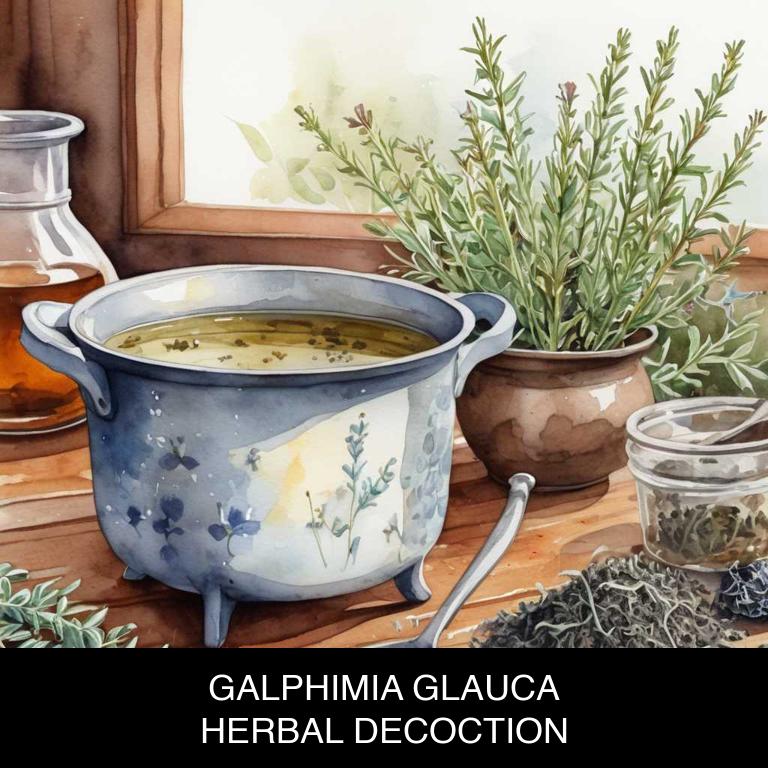
Medicinal Constituents
The list below shows the primary medicinal constituents in Galphimia glauca decoctions that help with allergies.
- Flavonoids: These plant-based compounds have anti-inflammatory and antioxidant properties, which can help reduce the severity of allergic reactions by mitigating inflammation and oxidative stress.
- Sesquiterpenes: These terpenoid compounds have been shown to possess anti-allergic activity by inhibiting the release of histamine, a key player in allergic reactions, from mast cells.
- Phenolic acids: These plant-based compounds have been found to exhibit anti-inflammatory and antioxidant properties, which can help alleviate symptoms of allergies by reducing inflammation and oxidative stress.
Parts Used
The list below shows the primary parts of yellow flower used to make decoctions for allergies.
- Leaves: Leaves are used due to their high content of flavonoids and other bioactive compounds that help alleviate allergy symptoms.
- Roots: Roots are used due to their anti-inflammatory properties, which help reduce swelling and itching associated with allergies.
- Stems: Stems are used due to their rich antioxidant content, which helps protect against oxidative stress and inflammation caused by allergic reactions.
Quick Recipe
The following recipe gives a procedure to make a basic yellow flower for allergies.
- Harvest 30-60 grams of dried galphimia glauca roots in late summer or early fall for maximum potency.
- Crush the dried roots into a fine powder using a mortar and pestle to release active compounds.
- Combine the powder with 1 liter of boiling water and steep for 10-15 minutes to create a decoction.
- Strain the decoction through a cheesecloth or fine-mesh sieve into a clean container to remove solids.
- Store the decoction in a cool dark place for up to 2 days before using or discard if contamination occurs.
9. Bacopa monnieri
Brahmi decoctions helps with allergies because of its anti-inflammatory and antioxidant properties, which work to reduce inflammation in the body and neutralize free radicals that can exacerbate allergic reactions.
Additionally, brahmi is known to modulate the immune system, helping to regulate an overactive response to allergens and reducing symptoms such as congestion, itchiness, and difficulty breathing.
By calming the body's reaction to allergens, brahmi decoctions provide natural relief for those suffering from seasonal or environmental allergies.
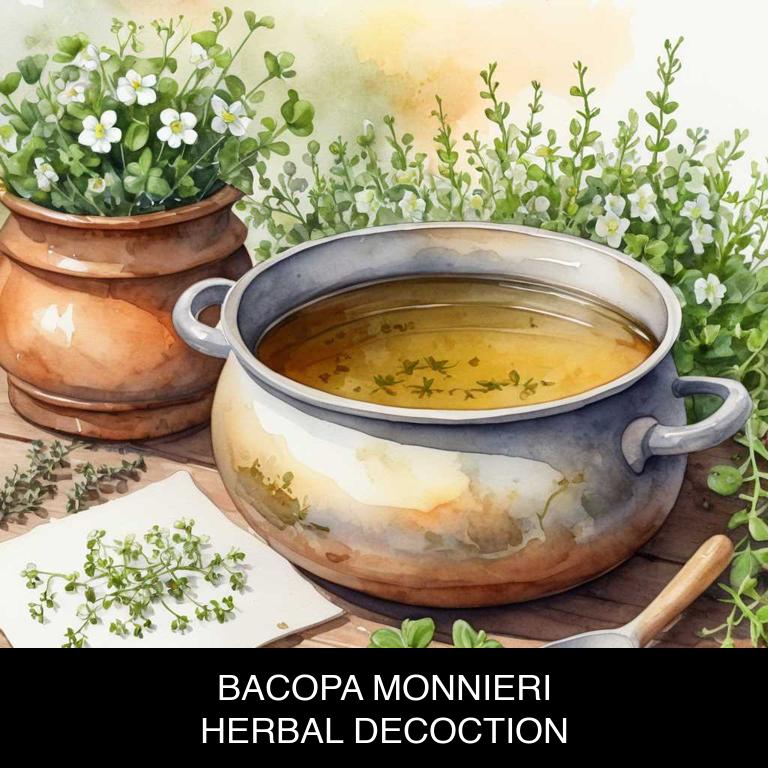
Medicinal Constituents
The list below shows the primary medicinal constituents in Bacopa monnieri decoctions that help with allergies.
- Bacopasides: Bacopasides have anti-inflammatory properties, which help reduce the allergic response by suppressing the production of pro-inflammatory mediators and cytokines that contribute to allergic reactions.
- Bacosides: Bacosides, particularly bacoside A, possess antioxidant and anti-inflammatory activities, which help neutralize free radicals and reduce inflammation in the body, thus alleviating allergic symptoms.
- Monnierine: Monnierine has been shown to possess anti-allergic and anti-inflammatory properties, which help inhibit the release of histamine and other mediators from mast cells, thereby reducing the severity of allergic reactions.
Parts Used
The list below shows the primary parts of brahmi used to make decoctions for allergies.
- Leaves: The leaves of Bacopa monnieri are the most commonly used part for decoctions due to their high concentration of bioactive compounds.
- Roots: The roots are also widely used for their bacosides, which are believed to have anti-inflammatory properties beneficial for allergy relief.
- Stems: The stems of Bacopa monnieri are used for decoctions as they contain some bioactive compounds that may help alleviate allergy symptoms.
Quick Recipe
The following recipe gives a procedure to make a basic brahmi for allergies.
- Harvest 40-60 grams of fresh bacopa monnieri leaves and stems or 16-24 grams of dried material.
- Chop the harvested material into small pieces to increase surface area for infusion.
- Combine the chopped material with 1 liter of boiling water and steep for 10-15 minutes.
- Strain the decoction through a cheesecloth or fine-mesh sieve into a clean container.
- Store the decoction in a cool dark place or refrigerate it for up to 24 hours.
10. Camellia sinensis
Tea decoctions helps with allergies because they contain natural anti-inflammatory compounds that can reduce congestion and ease respiratory symptoms.
The bioactive compounds in herbs such as peppermint, ginger, and turmeric have been shown to inhibit histamine release and alleviate allergy-related discomfort. Additionally, many herbal teas possess antiviral and antibacterial properties, which can help combat infections that often exacerbate allergies.
By soothing the body's natural response to allergens, herbal tea decoctions provide a holistic approach to managing allergic reactions.
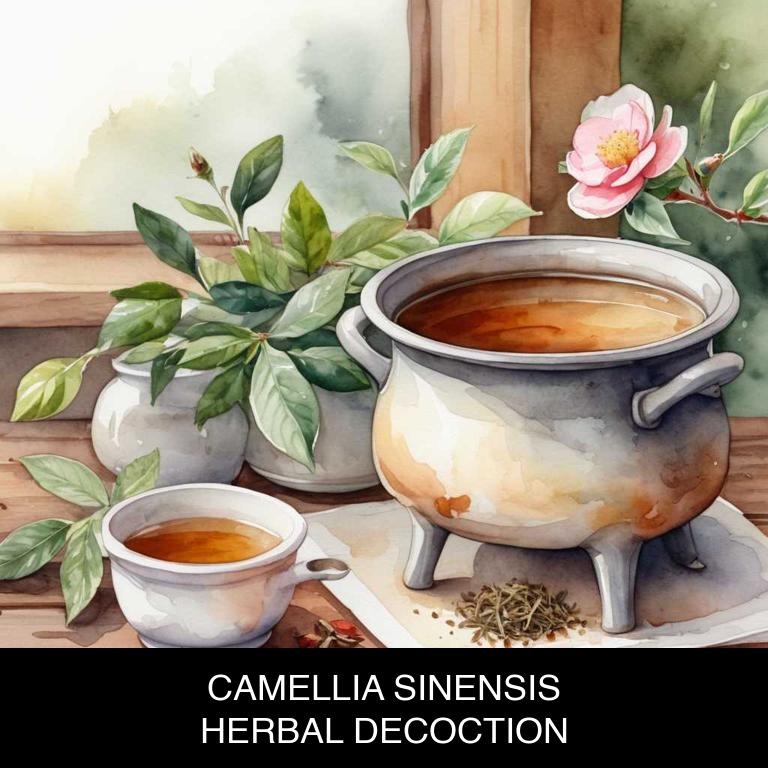
Medicinal Constituents
The list below shows the primary medicinal constituents in Camellia sinensis decoctions that help with allergies.
- Quercetin: This flavonoid helps with allergies by inhibiting the release of histamine, a chemical mediator involved in allergic reactions, and reducing inflammation and oxidative stress.
- Epigallocatechin gallate: This catechin has anti-inflammatory and antioxidant properties, which help to reduce the severity of allergic reactions by suppressing the production of pro-inflammatory cytokines and mediators.
- Theaflavins: These polyphenolic compounds have anti-inflammatory and immune-modulating effects, which help to alleviate allergic symptoms by inhibiting the production of histamine and other allergic mediators, and modulating the activity of immune cells.
Parts Used
The list below shows the primary parts of tea used to make decoctions for allergies.
- Leaves: The leaves are the most commonly used part for herbal teas, as they contain a significant amount of flavonoids that help alleviate allergy symptoms.
- Buds: The buds are used in traditional Chinese medicine to treat respiratory allergies, as they are believed to have anti-inflammatory and expectorant properties.
- Stems: The stems of Camellia sinensis, also known as tea stems, are sometimes used to make decoctions for allergies, as they contain flavonoids and other compounds that help soothe allergic reactions.
Quick Recipe
The following recipe gives a procedure to make a basic tea for allergies.
- Select 2 to 4 teaspoons of dried camellia sinensis leaves and transfer them to a heat-resistant glass or ceramic container.
- Bring 8 ounces of filtered water to a boil in a saucepan over medium-high heat for 5 to 7 minutes.
- Combine the boiling water with the dried camellia sinensis leaves in the heat-resistant container.
- Allow the mixture to steep for 3 to 5 minutes without covering the container to facilitate air circulation.
- Strain the decoction through a fine-mesh sieve or cheesecloth into a separate container to remove solids.
What is the best combination of herbal decoctions to use for allergies?
The best combination of herbal decoctions that help with allergies is a blend of Nettle leaf, Quercetin-rich Stinging Nettle root, and Anti-inflammatory Turmeric root.
The Nettle leaf and root help to reduce inflammation and alleviate symptoms, while Turmeric adds its potent anti-inflammatory properties to soothe the respiratory system. This combination can be consumed as a tea or added to a warm bath for a relaxing and therapeutic experience, providing natural relief from allergy symptoms.
Regular use can promote long-term wellness.
What ailments similar to allergies are treated with herbal decoctions?
Ailments similar to allergies/decoctions.html">allergies/decoctions.html">allergies that are treated with herbal decoctions are skin conditions such as eczema and dermatitis, which can be caused by environmental factors.
Herbal decoctions made from herbs like calendula, chamomile, and plantain can help soothe and calm irritated skin, reducing inflammation and itchiness.
Additionally, herbal decoctions may also be used to treat respiratory issues like asthma and bronchitis, which share similar symptoms with allergies such as congestion and wheezing.